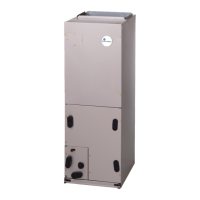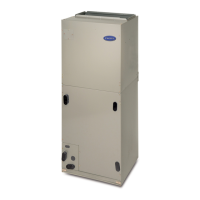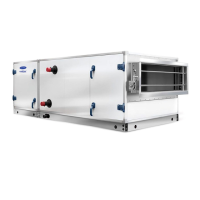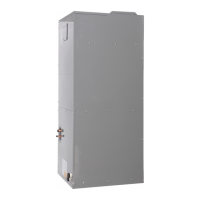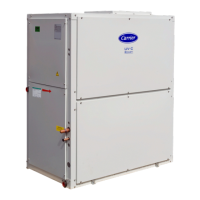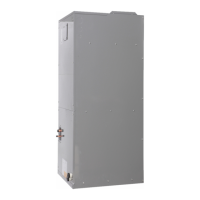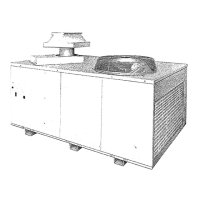130
unoccupied [Configuration
ALLM
SP.L.U] for 10 minutes),
then an alert will be broadcast. The alert will automatically reset.
T301 (Space Temperature Above Limit)
If the space temperature is above the configurable SPT High Alert
Limits (occupied [Configuration
ALLM
SP.H.O] for 5 min-
utes or unoccupied [Configuration
ALLM
SP.H.U] for
10 minutes), then an alert will be broadcast. The alert will auto-
matically reset.
T302 (Supply Temperature Below Limit)
If the supply-air temperature measured by the supply temperature
sensor is below the configurable SAT LO Alert Limit/Occ (Con-
figuration
ALLM
SA.L.O) for 5 minutes or the Low Supply
air temperature alert limit unoccupied mode (Configuration
ALLM
SA.L.U) for 10 minutes, then an alert will be broadcast.
T303 (Supply Temperature Above Limit)
If the supply temperature is above the configurable SAT HI Alert
Limit Occ (Configuration
ALLM
SAH.O) for 5 minutes or
the SAT HI Alert Limit/Unocc (Configuration
ALLM
SA.H.U) for 10 minutes, then an alert will be broadcast. The alert
will automatically reset.
T304 (Return Air Temperature Below Limit)
If the return air temperature measured by the RAT sensor is below
the configurable RAT LO Alert Limit/Occ (Configuration
ALLM
RA.L.O) for 5 minutes or RAT HI Alert Limit/Occ
(Configuration
ALLM
RA.L.U) for 10 minutes, then an alert
will be broadcast.
T305 (Return Air Temperature Above Limit)
If the return air temperature is below the RAT HI Alert Limit/Occ
(Configuration
ALLM
RA.H.O) for 5 minutes or RAT HI
Alert Limit/Occ (Configuration
ALLM
RA.H.U) for 10 min-
utes, then an alert will be broadcast. The alert will automatically
reset.
T308 (Return Air Relative Humidity Below Limit)
If the unit is configured to use a return air relative humidity sensor
through the Return Air RH Sensor (Configuration
UNIT
SENS
RRH.S) setting, and the measured level is below the con-
figurable RH Low Alert Limit (Configuration
ALLM
R.RH.L) for 5 minutes, then the alert will occur. The unit will con-
tinue to run and the alert will automatically reset.
T309 (Return Air Relative Humidity Above Limit)
If the unit is configured to use a return air relative humidity sensor
through the Return Air RH Sensor (Configuration
UNIT
SENS
RRH.S) setting, and the measured level is above the con-
figurable RH High Alert Limit (Configuration
ALLM
R.RH.H) for 5 minutes, then the alert will occur. Unit will contin-
ue to run and the alert will automatically reset.
T310 (Supply Duct Pressure Below Limit)
If the unit is a VAV unit with a supply duct pressure sensor and the
measured supply duct static pressure (Pressures
AIR.P
SP) is
below the configurable SP Low Alert Limit (Configuration
ALLM
SP.L) for 5 minutes, then the alert will occur. The unit
will continue to run and the alert will automatically reset.
T311 (Supply Duct Pressure Above Limit)
If the unit is a VAV unit with a supply duct pressure sensor and the
measured supply duct static pressure (Pressures
AIR.P
SP)
is above the configurable SP Low Alert Limit (Configuration
ALLM
SP.H) for 5 minutes, then the alert will occur. The unit
will continue to run and the alert will automatically reset.
T312 (Building Static Pressure Below Limit)
If the unit is configured to use modulating power exhaust, then a
building static pressure limit can be configured using the BP Low
Alert Limit (Configuration
ALLM
BP.L). If the measured
pressure (Pressures
AIR.P
BP) is below the limit for 5 min-
utes, then the alert will occur.
T313 (Building Static Pressure Above Limit)
If the unit is configured to use modulating power exhaust, then a
building static pressure limit can be configured using the BP HI
Alert Limit (Configuration
ALLM
BP.H). If the measured
pressure (Pressures
AIR.P
BP) is above the limit for 5 min-
utes, then the alert will occur.
T314 (IAQ Above Limit)
If the unit is configured to use a CO
2
sensor and the level (In-
puts
AIR.Q
IAQ) is above the configurable IAQ High Alert
Limit (Configuration
ALLM
IAQ.H) for 5 minutes, then the
alert will occur. The unit will continue to run and the alert will au-
tomatically reset.
T316 (OAT Below Limit)
If the outside-air temperature measured by the OAT thermistor
(Temperatures
AIR.T
OAT) is below the configurable OAT
Low Alert Limit (Configuration
ALLM
OAT.L) for
5 minutes, then the alert will be broadcast.
T317 (OAT Above Limit)
If the outside-air temperature measured by the OAT thermistor
(Temperatures
AIR.T
OAT) is above the configurable OAT
High Alert Limit (Configuration
ALLM
OAT.H) for 5 min-
utes, then the alert will be broadcast.
T335 (Excess Outdoor Air)
When the control detects a stuck or jammed actuator, it will com-
pare the stuck position to the command position to log additional
alerts. If the stuck position > commanded position, the alert is set.
A400 (Hydronic Freezestat Trip)
If the freezestat for the hydronic coil trips, the unit goes into emer-
gency mode and does not allow cooling or heating. The economiz-
er goes to 0% open. Supply fan operation is enabled. Recovery is
automatic when the switch goes off.
A404 (Fire Shut Down Emergency Mode [fire-smoke])
If the fire shutdown input is energized (fire shutdown is in effect),
or if two fire smoke modes are incorrectly energized at the same
time, a Fire Shutdown mode will occur. This is an emergency
mode requiring the complete shutdown of the unit. Recovery is
automatic when the inputs are no longer on.
A405 (Evacuation Emergency Mode)
If the evacuation input on the CEM is energized, an evacuation
mode occurs which flags an alarm. This mode attempts to lower
the pressure of the space to prevent smoke from moving into an-
other space. This is the reverse of the Pressurization Mode. Clos-
ing the economizer, opening the return-air damper, turning on the
power exhaust, and shutting down the indoor fan will decrease
pressure in the space. Recovery is automatic when the input is no
longer on.
A406 (Pressurization Emergency Mode)
If the pressurization input on the CEM is energized, a pressuriza-
tion mode occurs which flags an alarm. This mode attempts to
raise the pressure of a space to prevent smoke infiltration from
another space. The space with smoke should be in an Evacuation
Mode attempting to lower its pressure. Opening the economizer,
closing the return air damper, shutting down power exhaust, and
turning the indoor fan on will increase pressure in the space. Re-
covery is automatic when the input is no longer on.
A407 (Smoke Purge Emergency Mode)
If the smoke purge input on the CEM is energized, a smoke purge
mode occurs which flags an alarm. This mode attempts to draw
out smoke from the space after the emergency condition. Opening
the economizer, closing the return-air damper, and turning on both
the power exhaust and indoor fan will evacuate smoke and bring
in fresh air. Recovery is automatic when the input is no longer on.

